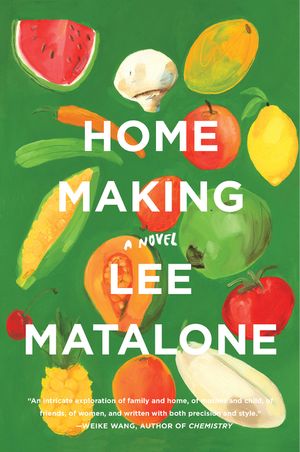Home Making: A Novel
- By Lee Matalone
- Harper Perennial
- 208 pp.
- Reviewed by Terri Lewis
- March 2, 2020
This debut uses structure as metaphor to take on the themes of adoption, identity, and femininity.

As Home Making begins, a baby girl born to an unnamed Japanese woman and French man is given up to an orphanage. When the child, Ayumi, is 2 years old, she grabs the sleeve of an American passing her crib and is adopted and taken to the U.S.
In her new, all-white family, she’s renamed Cybil, a brown-skinned, blue-eyed girl who the neighbors think is Navajo. In a few quick pages, she grows up, falls in and out of love, becomes a doctor, and finally has a baby of her own, Chloe, for whom she vows to do everything.
After this opening, the story abandons traditional narrative; the second chapter is a kaleidoscope of short, seemingly disconnected sections as a now-grown Chloe struggles with a move to a house requiring updates and repairs. She puts off her mother’s visit, makes to-do lists, harasses a telemarketer, comments on Le Corbusier and an Angolan prisoner, and asks her gay friend Beau to bring groceries.
However, every section links in some way to her need to create a home for herself. In the middle of the chapter, a sick husband is mentioned, and slowly it becomes clear that he has sent her to the new house and kept the old one, where he plans to die alone. The discontinuous paragraphs mimic Chloe’s disjointedness in her panic and pain.
The novel later circles back to narrate the long-ago flight to the U.S. and Ayumi’s transformation into Cybil, then lands again on Chloe in a series of chapters named for whichever room of the house she’s currently redoing or planning to redo (it’s never clear if repairs are actually made).
Working through the kitchen, guest bedroom, guest bath, downstairs hall closet, garage, and back yard, Chloe follows her thoughts as they scatter and coalesce. Lists are made of colors, with white being prominent, an enduring symbol of Cybil’s cold adoptive family.
Embedded in the chapters are brief memories of Chloe’s marriage that somehow tie into the room at hand. For instance, in Dining Room — amid riffs on wallpaper, a meditation on castles, and listening to the police scanner — she remembers a picnic with her husband when they sat on a red blanket and he deliberately broke a plate as a pledge to their future.
The chapter entitled Master Bath contains what seems the heart of their marriage: a ritual of bathing together at the end of the day. Now, Chloe has lost “the habitual, iterable [sic] moments of contained joy that slow time.”
Eventually, the reader learns that Chloe’s husband bought her out of the home they’d shared together. He doesn’t want her to suffer with him. “He left me in a position where I couldn’t harbor even a modicum of anger toward him.”
Although the opening is misleading, with its traditional narrative, once the form is understood and the underlying story begins to take shape, reading Home Making becomes a pleasure, full of weird jumps, interesting encounters, and beautiful images:
“When people go, the things they leave behind can feel haunted. A father can take your left ventricle and a husband can take your frontal lobe, leaving behind a tea kettle, a lamp shade from Bed Bath & Beyond. A wooden spoon can hold the existential weight of a family Bible while you turn into a shell.”
The homosexual Beau becomes more important as the story progresses. He and Chloe share a connection of complete trust and unusual longing. At one point, he sits on folded towels on the toilet while Chloe bathes:
“Bubbles frame her breasts like scales on a fish. Her limbs are lithe and translucent, her veins swimming blue against the edges of her skin.” Their relationship is almost, but not quite, sexual. They “raise flags of passion that turn out to be just shadows.”
The structure of the novel allows myriad ideas to bloom and fade. Important themes surface — loneliness, being a woman of color in a white world, love, motherhood, the guilt of adultery — but often are underdeveloped and therefore don’t always resonate. The mother, Cybil, doesn’t register strongly, and Beau isn’t fully realized beyond his connection to Chloe, despite an attempt to flesh him out in a later chapter.
There’s a surprising twist toward the end, after which the story morphs again as the last chapters rush toward a traditional conclusion, not in the sense of what happens, but in how it’s told. With this change, some of the magic is lost.
Home Making isn’t for everyone. It requires a patient reader to accept the unusual structure, to find interest in Chloe’s various passions as she tries to make sense of her life, and to suspend disbelief at some characters’ motivations.
Yet, for a first novel, it’s wide-ranging and ambitious. It will be interesting to see how author Lee Matalone develops as a writer and, more crucially, as a storyteller.
Terri Lewis is finishing a novel. She is in the process of moving from Palm Bay, FL, to Denver with her husband and a dog, Tango, who belongs in the circus.

_80_120.png)